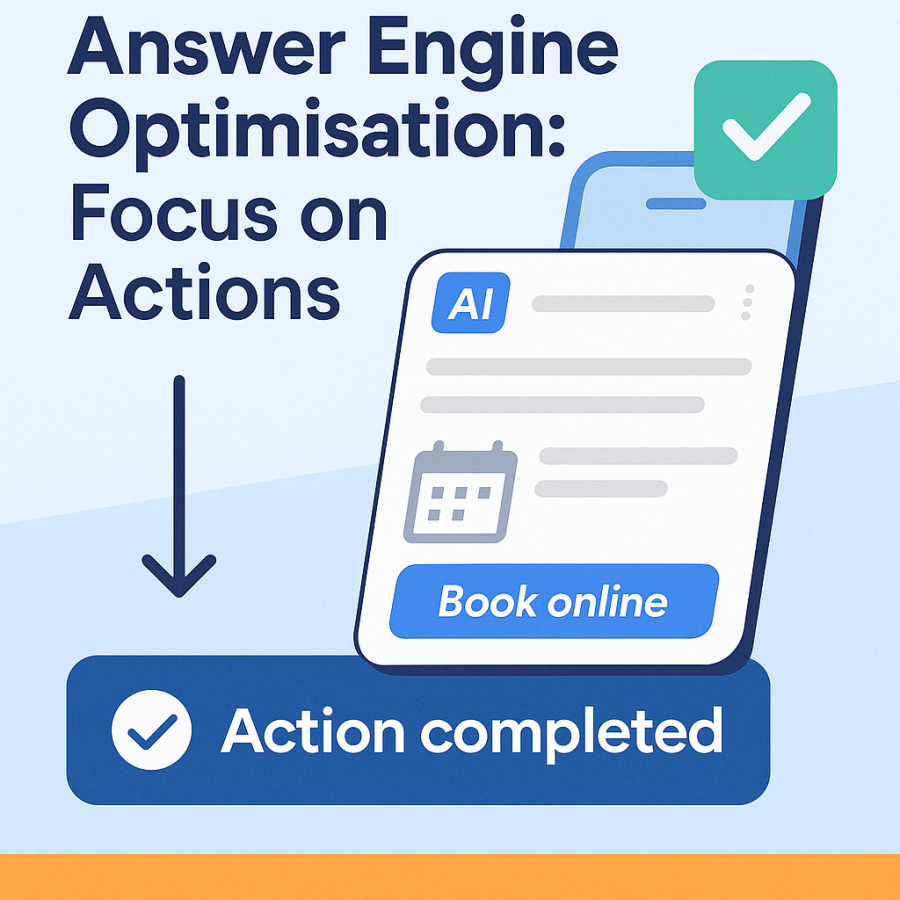AI Mode just went global(‑ish). AEO now means optimising for actions, not just answers.
Google’s AI Mode is expanding worldwide and starting to do things for users—like booking restaurants. That shifts Answer Engine Optimisation from “be the cited source” to “be the service that gets the tap.” blog.googleThe Verge
What changed this week
Google announced new agentic features in AI Mode—beginning with restaurant bookings via OpenTable, Resy and Tock—and a broader international rollout (English‑only for now). US users in Labs also get more personalised results and shareable AI Mode conversations. Practically, Search is becoming a chat‑first assistant that can complete tasks without leaving the results.
At the same time, publishers continue to warn of shrinking referral traffic from AI answers—a “Google Zero” scenario where queries resolve on‑SERP. Whether or not it’s universal, the directional signal is clear: clicks consolidate; completion events rise.
Why this matters for AEO
Traditional SEO optimises for ranking; AEO optimises for resolution. When AI Mode handles intent end‑to‑end, winners are the entities the assistant trusts to fulfil the task now. That means your content, data and connectors must prove:
-
you’re the right entity, 2) you’re available, and 3) you’re easy to transact with in one hop.
Google also claims AI Overviews/Mode drive “more queries and higher‑quality clicks.” If your analytics aren’t reflecting that, assume distribution is shifting towards tasks and aggregators—and adapt your measurement and surfaces accordingly.
The AEO playbook for agentic search
1) Treat structured data as your interface.
Use correct, complete JSON‑LD for Organization, LocalBusiness (or niche subtype), Product/Offer, HowTo/FAQ (where still eligible), Reviews, and events/menus where relevant. Keep feeds and schema fresh; missing availability kills conversions in AI contexts. Test in Rich Results and monitor Search Console enhancements.
2) Optimise your aggregator presence as hard as your site.
If bookings are brokered through partners (OpenTable/Resy/Tock in this launch), ensure your listings, menus, hours, and inventory are pristine and synced. AI Mode linking to those platforms means that page may be the first interaction—so branding, photos, and reviews there are part of AEO.
3) Build “answer‑ready” pages that resolve intents in one scroll.
Craft concise, sourceable summaries high on the page (think 100–200 words), then deep detail. Use stable, crawlable headings and anchors that a model can cite or jump‑link to. Surface proof (policies, guarantees, accreditations) close to the conversion element.
4) Strengthen entity signals.
Ensure consistent NAP, sameAs links (Wikidata, Wikipedia, major profiles), and internal “about/brand” hubs. Entity clarity helps assistants map your brand as the canonical fulfiller for a topic/location.
5) Speed + UX = ranking for actions.
AI agents favour predictable, fast experiences. Ship sub‑2s LCP, no layout shifts, and minimal interstitials. Use well‑named buttons (“Book table”, “Get quote”) and instrument them for analytics.
6) Instrument the new funnel.
Track:
-
Assists (impressions without clicks where branded demand or direct bookings rise)
-
Aggregator conversions (UTMs where possible, or reconcile via reservation/lead IDs)
-
Query mix changes (more long/complex tasks = AI Mode exposure)
Benchmark before/after AI Mode availability in your markets.
7) Keep receipts—attribution and transparency are moving targets.
Perplexity just deprecated its legacy citations field in favour of richer search_results with titles/URLs/dates—another reminder that source display and tracing are evolving across answer engines. Expect similar churn elsewhere; design your reporting to cope with shifting schemas.
Practical next steps this week
-
Audit schema & feeds: Validate JSON‑LD; confirm availability/pricing freshness; add missing sameAs.
-
Aggregator sweep: Update and standardise listings on OpenTable/Resy/Tock (or your sector’s equivalents).
-
Create 3 “resolution hubs”: One‑scroll, skimmable pages for your top tasks (e.g., “Book a [Service] in [Suburb] today”).
-
Add assistant‑friendly CTAs: Clear action verbs; structured data for actions where supported.
-
Rework KPIs: Add assists, aggregator conversions, and task completion rate alongside classic SEO metrics.
The bigger picture
Search is shifting from results to results + runtime. If your brand is invisible to the runtime—because data isn’t structured, inventory isn’t exposed, or partners are messy—you’ll watch intent resolve without you. AEO in 2025 is about being the cleanest, clearest, callable option when the agent decides to act.

Phone Number: 0400 928 999
Email Address: mark@ienhance.com.au
Author: Mark Edwards
iEnhance was founded by Mark Edwards in 2007. Mark has directed and managed countless successful digital marketing campaigns since inception, including clients in advertising spaces such as Telecommunication, Holiday Letting, Business Brokerages, Real Estate, and Transportation, as well as numourous small businesses. Whilst budgets and campaign sizes can vary, Mark prides himself in the personal service that iEnhance still provides.
Initially running with a strong Search Engine Optimisation foundation, iEnhance has evolved and now looks at a digital campaign holistically. As a Certified Google Partner Mark has managed Search and Display campaigns in the Google network since the Google Partner program began and is now also Certified in Google Analytics, meaning that data and tracking is his thing.

